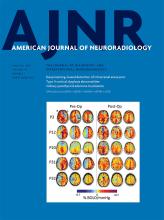Research ArticleAdult Brain
Deep Learning–Based Detection of Intracranial Aneurysms in 3D TOF-MRA
T. Sichtermann, A. Faron, R. Sijben, N. Teichert, J. Freiherr and M. Wiesmann
American Journal of Neuroradiology January 2019, 40 (1) 25-32; DOI: https://doi.org/10.3174/ajnr.A5911
T. Sichtermann
aFrom the Department of Diagnostic and Interventional Neuroradiology (T.S., A.F., R.S., N.T., J.F., M.W.), University Hospital RWTH Aachen, Aachen, Germany
A. Faron
aFrom the Department of Diagnostic and Interventional Neuroradiology (T.S., A.F., R.S., N.T., J.F., M.W.), University Hospital RWTH Aachen, Aachen, Germany
bDepartment of Radiology (A.F.), University Hospital Bonn, Bonn, Germany
R. Sijben
aFrom the Department of Diagnostic and Interventional Neuroradiology (T.S., A.F., R.S., N.T., J.F., M.W.), University Hospital RWTH Aachen, Aachen, Germany
N. Teichert
aFrom the Department of Diagnostic and Interventional Neuroradiology (T.S., A.F., R.S., N.T., J.F., M.W.), University Hospital RWTH Aachen, Aachen, Germany
bDepartment of Radiology (A.F.), University Hospital Bonn, Bonn, Germany
J. Freiherr
aFrom the Department of Diagnostic and Interventional Neuroradiology (T.S., A.F., R.S., N.T., J.F., M.W.), University Hospital RWTH Aachen, Aachen, Germany
M. Wiesmann
aFrom the Department of Diagnostic and Interventional Neuroradiology (T.S., A.F., R.S., N.T., J.F., M.W.), University Hospital RWTH Aachen, Aachen, Germany

References
- 1.↵
- Vlak MH,
- Algra A,
- Brandenburg R, et al
- 2.↵
- 3.↵
- Nieuwkamp DJ,
- Setz LE,
- Algra A, et al
- 4.↵
- Lindgren AE,
- Koivisto T,
- Björkman J, et al
- 5.↵
- Thompson BG,
- Brown RD Jr.,
- Amin-Hanjani S, et al
- 6.↵
- Wiebers DO,
- Whisnant JP,
- Huston J 3rd., et al
- 7.↵
- Leffers AM,
- Wagner A
- 8.↵
- Wang S,
- Summers RM
- 9.↵
- 10.↵
- 11.↵
- 12.↵
- Krizhevsky A,
- Sutskever I,
- Hinton GE
- 13.↵
- 14.↵
- Miki S,
- Hayashi N,
- Masutani Y, et al
- 15.↵
- Štepán-Buksakowska IL,
- Accurso JM,
- Diehn FE, et al
- 16.↵
- 17.↵
- 18.↵
- 19.↵
- Kamnitsas K
- 20.↵
- Jenkinson M,
- Pechaud M,
- Smith S
- 21.↵
- Tustison NJ,
- Avants BB,
- Cook PA, et al
- 22.↵
- Yushkevich PA,
- Piven J,
- Hazlett HC, et al
- 23.↵
- Kamnitsas K,
- Chen LC,
- Ledig C, et al
- 24.↵
- 25.↵
- Tustison NJ,
- Avants BB,
- Cook PA, et al
- 26.↵
- 27.↵
- MacDonald SL,
- Cowan IA,
- Floyd R, et al
- 28.↵
- Berbaum KS,
- Franken EA Jr.,
- Dorfman DD, et al
- 29.↵
- Mazzara GP,
- Velthuizen RP,
- Pearlman JL, et al
- 30.↵
- Nomura Y,
- Masutani Y,
- Miki S, et al
- 31.↵
- 32.↵
- Kamnitsas K
In this issue
American Journal of Neuroradiology
Vol. 40, Issue 1
1 Jan 2019
Advertisement
T. Sichtermann, A. Faron, R. Sijben, N. Teichert, J. Freiherr, M. Wiesmann
Deep Learning–Based Detection of Intracranial Aneurysms in 3D TOF-MRA
American Journal of Neuroradiology Jan 2019, 40 (1) 25-32; DOI: 10.3174/ajnr.A5911
0 Responses
Jump to section
Related Articles
- No related articles found.
Cited By...
- Accuracy of an nnUNet Neural Network for the Automatic Segmentation of Intracranial Aneurysms, Their Parent Vessels, and Major Cerebral Arteries from MRI-TOF
- Non-invasive imaging modalities for diagnosing pulsatile tinnitus: a comprehensive review and recommended imaging algorithm
- Diagnosis of intracranial aneurysms by computed tomography angiography using deep learning-based detection and segmentation
- Automation Bias in AI-Assisted Detection of Cerebral Aneurysms on Time-of-Flight MR-Angiography
- Deep learning-based cerebral aneurysm segmentation and morphological analysis with three-dimensional rotational angiography
- Deep learning-based cerebral aneurysm segmentation and morphological analysis with three-dimensional rotational angiography
- Automated Detection of Cerebral Aneurysms on TOF-MRA Using a Deep Learning Approach: An External Validation Study
- Deep Learning-Based Software Improves Clinicians' Detection Sensitivity of Aneurysms on Brain TOF-MRA
- Fully automated intracranial aneurysm detection and segmentation from digital subtraction angiography series using an end-to-end spatiotemporal deep neural network
- Artificial Intelligence in Neuroradiology: Current Status and Future Directions
- Detection of clustered anomalies in single-voxel morphometry as a rapid automated method for identifying intracranial aneurysms
- Artificial Intelligence in the Management of Intracranial Aneurysms: Current Status and Future Perspectives
This article has not yet been cited by articles in journals that are participating in Crossref Cited-by Linking.
More in this TOC Section
Adult Brain
Similar Articles
Advertisement











